Berg Everlasting Style Chisel?
Contributed by Randall Nelson
I recently got an old Berg deep gouge that was part of a larger group of old tools. The blade is stamped with a small example of the Berg “modern” shark, which means it was made sometime after that style of stamp was adopted in the mid 1930’s. It has a wooden handle that was heavily wrapped with the old-style black fabric electrician’s tape, which hasn’t been used since the 1960’s. I assumed that meant that the handle was cracked, since taping is the simplest way to do a quick field repair on a cracked handle. The chisel felt very heavy and had some type of metal cap attached to the end of the handle. The blade was out of alignment with the handle, but all my attempts to loosen the blade from the wrapped handle were unsuccessful. At that point I decided to remove the tape from the handle and get a better look at what I had just gotten.

When I removed the tape I could see that this was something quite unusual and I wondered if this was actually a Berg factory production tool or something that had been user-made. The handle, which is beech wood (an unusual choice for a Berg tool) had been made in the typical Swedish style but it had several odd features.
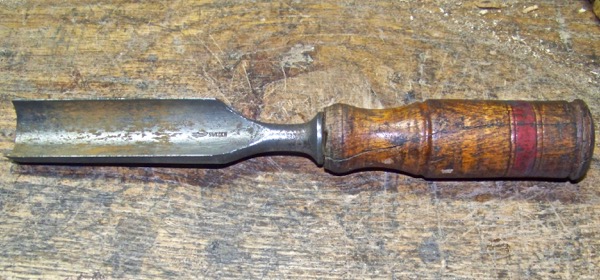
First, there is no brass ferrule between the blade and the handle. Second, the classic Swedish pattern of the 3 sets of paired decorative rings had not been followed. The two pairs of rings on the upper barrel of the handle were in not in the standard position, but were placed together, 2/3rds of the way up the barrel, spaced about 3/8” apart, with the space between painted red. And most obviously, instead of the usual hammer ring and wooden dome at the end, the handle had been slightly hollowed out, so that a tapered metal striking cap could be fitted into the end of the handle. Everything is still solid, with no play or give to the assembly, although the metal end cap is now out of alignment and is no longer tight to the wooden handle. This is probably the result of heavy use, since the metal cap shows evidence of severe pounding with a steel hammer.


The handle is cracked, but it is still functional and was turned from one piece of beech wood. However, this chisel did not seem to be made from three separate pieces of metal; the blade, the ferrule and the end cap/shaft all joined together with a turned wood handle, the way Stanley made their Everlast chisels.

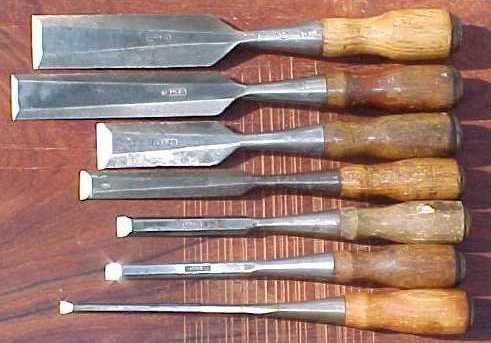
I started looking at the tool and thinking about how it might have been assembled if I were designing it. I have tried to visualize what is going on inside the handle. I thought that, instead of the usual tang going into the handle there had to be a metal rod, (possibly square, not round, so that the wood handle would stay tight and not turn) that extends from the bolster up the full length of the handle to connect to the end cap and possibly through it. But upon closer inspection, the end cap does not show any evidence of a rod having extended through the cap and being peened over or welded, as I had expected to find.

My best guess is that the extended tang/rod was threaded on the end and screwed into a corresponding threaded hole in the under-side of the solid cap. As this was screwed together at the factory, it would have tightened the whole assembly. However, when I tried to unscrew the end cap from the handle I was unsuccessful; either the threads are now mashed from repeated hammer blows to the end cap, or the connection is rusted, or possibly they used an adhesive to re-enforce the bond of the threads when they assembled the tool. Any of these scenarios would make it extremely difficult to take the tool apart at this point. Of course, my concept of the assembly design could also be all wrong and I certainly don’t want to ruin the tool by trying to force the end cap off. All of this is only conjecture on my part and I don’t have any intention of making any further attempts to disassemble the tool just to prove my design theory. Maybe I should have invested in a pair of those x-ray glasses they were always advertising in the back pages of comic books when I was a kid!
There is also a red stripe painted around the handle, between the two sets of turned rings. It looks to be original, not something added later by an owner. This is a feature I have seen repeatedly on Swedish chisel handles, mostly gouges, but I am not sure what it indicates. It might be a form of seller’s mark, possibly applied by a hardware seller in Sweden, like the famous Edward Zinn “Elephant” stamps encountered on Berg chisels sold by that NY importer. However, it certainly was not a standard feature on other Berg tools.

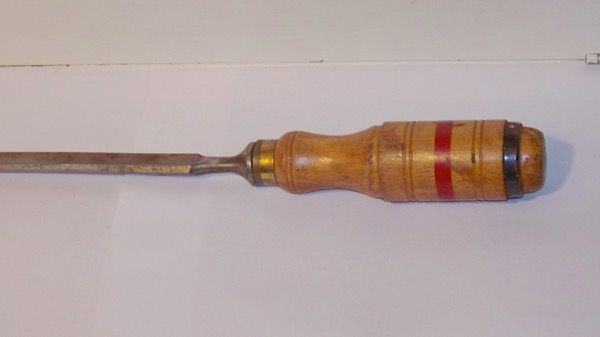

After all this inspection, I concluded that this must be a factory-made tool; there is just too much engineering involved for it to have been user-made. I suspect that this was an attempt by Berg to produce a competitor to the Stanley Everlast style of heavy-duty chisel from the 1920’s, which featured a similar steel rod, wood handle and steel end cap construction. But Stanley only made their Everlast line of chisels as flat carpenter’s chisels, never as wood gouges. The fact that this tool was assembled by Berg as a gouge seems like a strange choice, since most gouge chisels are made to be used by hand pressure or are only struck with a wooden mallet, not by a steel hammer. The one exception to that rule is the famous “plumber’s gouge”, possibly the single most abused style of wood carving tool ever made. It was typically used to cut a hole through foundation framing to clear a passage for piping, back in the days before large-diameter drill bits and slow speed heavy-duty electric drills became readily available. Such a chisel would have been carried in the plumber’s tool bag along with his wrenches and other tools. When I was a boy in the 1950’s my father had one that he used that was all steel, like a large cold chisel-style gouge. It had probably been made for him by a local blacksmith.

In Berg’s case this would have been their model 933 Strong Firmer Gouge, usually equipped with the 958 heavy-duty handle. It was a large in-cannel gouge expressly made for chopping a round hole through heavy material. Most examples of this tool that I have seen are in very rough shape from the extreme use they have received while in service. Examples of the model 933 Gouge hardly ever appear for sale on Ebay, so they must not have been a very big seller for Berg.
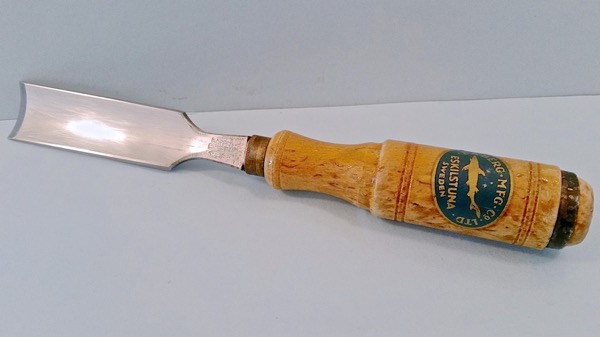
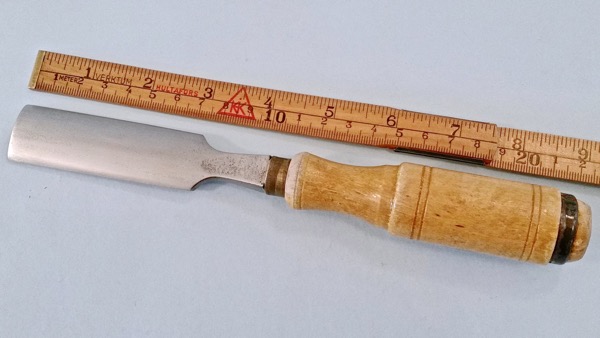
However, this unusual heavy-duty gouge chisel was not made as an in-cannel hole chopper, but as the more typical out-cannel style carving chisel. Possibly this was a new design attempt by Berg to make a stronger version of their standard carving gouge that they hoped would hold up better to use with a steel hammer. In its construction they had used the regular Berg model 928 Full Hollow Gouge carving chisel blade design, not the much stronger blade design of the model 933 Strong Firmer Gouge. This would indicate that they were hoping to sell this “improved” model to their general wood carving customers, not just to the more specialized framers and plumbers trade that you would have expected them to target for such a product.
Since this is the only version of a Berg “Everlasting” chisel that I have ever encountered, I feel pretty sure it never made it into standard production. I am guessing that the amount of special assembly required to produce this chisel design would have made this a difficult tool to produce economically. The process would have started with a differently forged blade design, fitted to a differently turned handle. The longer central tang/rod would need to be cut to length, then threaded on the end. The cap would also need to be drilled and threaded, then final assembly would have been done by hand. Also, the new handle design made this tool quite a bit heavier than the regular gouge design and so was probably uncomfortable to use for the average wood worker doing some simple carving application. For all these reasons, I think this was just an experimental model.
But maybe, like the elusive Berg Crank-Neck Patternmaker’s chisels I have written about elsewhere, this chisel was a special order tool, made for a specific customer who was willing to pay extra to have the Berg Company make a tool to their specifications. From the amount of wear this tool exhibits it’s pretty obvious that someone got some real use out of this chisel, so it must have been what they wanted. I wonder what that would have cost for a tradesman of the day? And if I’m right about this, then there may be many more “odd-ball” Berg tools out there, still waiting for sharp-eyed users and collectors to discover. Of course, another possibility is that Stanley found out about this chisel design being offered by the Berg Company and threatened them with a patent infringement lawsuit if they continued to produce any more of them, so they never did.

Later, with the introduction of the new “unbreakable” plastic handles, which were easier to make and install and for which Berg actually charged a premium, management would probably have felt that any practical need for this heavy-duty “Everlasting” style of chisel handle no longer existed. By the time the “Bergplast” handles became available, I believe the Model 933 Gouge was no longer in production and had been dropped from the catalog, as had their other earlier “heavy-duty” models.
It would certainly be interesting to know if the Berg Company had kept any files on their experimental or “one of” production. And if they did, after so many corporate changes, I wonder where those old files would possibly be stored now? Maybe they’re still sitting in a file cabinet in an old back office storage room somewhere in Eskilstuna. Anyone want to play detective?
Contributed by Randall Nelson
Can you see the metal inside the handle? Through the crack perhaps or feel it with for example a thin awl. I have run into an old Eskilstuna chisel that had a steel cap at the back but the tang of the chisel was the usual model. The cap looked much like yours, perhaps a bit more domed shaped. This was some years ago, so I’m sorry to say can’t recall the manufacturer, just that it was Eskilstuna and that it looked a little older then your chisel.
Offcourse it could have been something that someone added after buying the chisel, but I remembered it looked quite professional made
Anders C: I have tried to get an idea about what is happening inside that handle, but the crack is tight and I do not wish to damage this item by probing. Hopefully, more such items will appear and help answer some of these questions that we still have. Too bad you you didn’t hold onto that chisel with the metal cap that you saw- it might have been from the same production run!